
Since June 30, 1993, Malta has been subdivided into 68 localities, governed by local councils, Maltese: kunsilli lokali, meaning municipalities or borough, and the considered by the Maltese as the equivalent to a basic village or towns, where appropriate. These form the most basic type of local government and are subdivisions of the country's first-level regions.

Giuseppe Calì was a Maltese painter of Italian descent.

The Maltese Premier League, known as 360Sports Malta Premier for sponsorship reasons with 360Sports, is the highest level of professional football in Malta. Managed by the Malta Football Association, the Premier League is contested by 12 teams and operates on a promotion and relegation system with the Challenge League. As of June 2022, the Premier League ranks 46th out of 55 members in the UEFA coefficient.

Mqabba is a town in the Southern Region of Malta. It has a traditional Maltese village layout, with a population of about 3,339 inhabitants, as of January 2019. The focal point is the Parish Church of the Assumption, found at the core of the village. It has two band clubs, a number of gardens and a list of national monuments. The motto of the village is 'Non Nisi Per Ardua' which translates into 'Only with Ability'.
Malta is the country with the most holidays in the European Union. Since 2020, any holidays falling on Saturdays or Sundays add an extra day to the workers' leave pool, reverting to the pre 2005 system.

Malta is for non-local government purposes divided into districts as opposed to the local government localities. The three main types of such districts – statistical, electoral at national level, and policing – have no mainstream administrative effect as the local councils form the first-tier – moreover only administrative tier – divisions of the country.
This page list topics related to Malta.

Malta adopted a new telephone numbering plan in 2001–2002, in which telephone numbers were expanded to eight digits for fixed line and mobile numbers. Previously, fixed line numbers were six digits, while mobile, mailbox and pager services were seven digits long.
Church of the Assumption or Church of the Assumption of Mary may refer to:
Post codes in Malta are seven-character strings that form part of a postal address in Malta. Post codes were first introduced in 1991 by the mail operator MaltaPost. Like those in the United Kingdom and Canada, they are alphanumeric.

In Malta, most of the main roads are in the outskirts of the localities to connect one urban area with another urban area. The most important roads are those that connect the south of the island with the northern part, like Tal-Barrani Road, Aldo Moro Street in Marsa and Birkirkara Bypass.
The 2017–18 Maltese FA Trophy was the 80th version of the football tournament. It was sponsored by Boost Diesel, which was revealed during the draws of the first, second and third round of the Maltese FA Trophy at the Trophies Lounge in Malta Football Association headquarters in Ta' Qali. A total of sixty–four clubs participated in this season's cup competition.

The 2018–19 Maltese FA Trophy was the 81st edition of the football cup competition. A record number of 67 clubs competed in the FA Trophy, with the first round starting on the weekend of 1–2 September 2018 and concluding with the final played on 18 May 2019.
The 2019–20 Maltese FA Trophy was the 82nd edition of the football cup competition.

The 2022–23 Maltese FA Trophy, officially named IZIBET FA Trophy due to sponsorship reasons, is the 85th edition of the football cup competition, the FA Trophy. The winners of the Maltese FA Trophy will earn a place in the first qualifying round of the 2023–24 UEFA Europa Conference League. The first round of games started on 15 November 2022.











